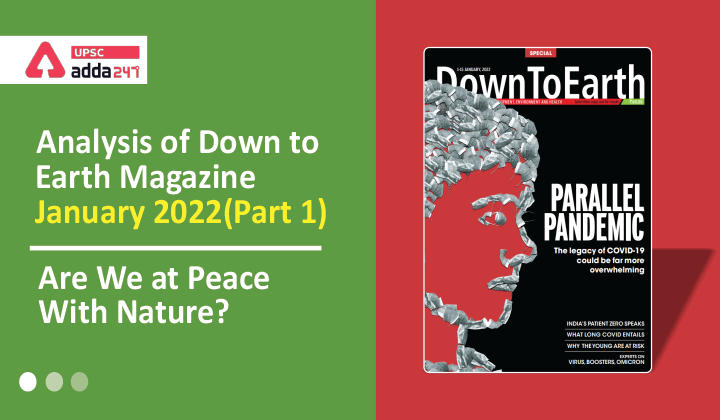Table of Contents
Introduction
- Our climate is changing. As the planet heats up, infectious diseases that were once confined to warmer latitudes are slowly expanding their range.
- In particular, zoonotic diseases – diseases that spread from non-human animals to humans – are taking advantage of the greater range made available by climate change.
- UNEP’s new report offers a blueprint for the sustainable world we need, with practical recommendations on how to tackle the three planetary crises of climate change, biodiversity loss and pollution.
Was climate change a causal factor of the COVID-19 outbreak?
- In January of 2021, a paper published in the journal Science of the Total Environment revealed evidence that climate change may have played a direct causal role in the emergence of the virus responsible for the COVID-19 pandemic, severe acute respiratory syndrome coronavirus 2 (SARS-CoV-2).
- An international team of scientists from institutions in the UK, Germany, and the US were able to link the climatic changes that occur as a result of climate change directly to COVID-19. They emphasize that the number of bat species present is linked with the number of coronaviruses in a particular environment.
- Due to climate change, factors such as temperature, atmospheric carbon dioxide, and cloud cover are evolving. These factors have a direct impact on the growth of plants and trees. Therefore, climate change is affecting natural habitats and ecosystems via altering environmental factors.
- Even subtle adjustments can have a great impact on the species living within an ecosystem.
Climate Change and frequent Outbreaks of diseases
- For centuries humans have known that climatic conditions affect epidemic infections—since well before the basic notion of infectious agents was understood late in the nineteenth century.
- COVID-19 is not the only infectious disease linked to climate change. For many years the World Health Organization (WHO) has highlighted the link between changing environmental conditions and epidemic diseases.
- It is hoped that now, this link may take centre stage, forcing policy-makers to consider the wide-reaching impact of climate change and make calculated strategies to prevent further environmental damage and reverse, where possible, the damage that has already occurred.
WHO on the link between Climate Change and Health
- Climate change affects the social and environmental determinants of health – clean air, safe drinking water, sufficient food and secure shelter.
- Between 2030 and 2050, climate change is expected to cause approximately 250 000 additional deaths per year, from malnutrition, malaria, diarrhoea and heat stress.
- The direct damage costs to health (i.e. excluding costs in health-determining sectors such as agriculture and water and sanitation), is estimated to be between USD 2-4 billion/year by 2030.
- Areas with weak health infrastructure – mostly in developing countries – will be the least able to cope without assistance to prepare and respond.
- Reducing emissions of greenhouse gases through better transport, food and energy-use choices can result in improved health, particularly through reduced air pollution.
What are Zoonotic Diseases?
- Animals can sometimes carry harmful germs that can spread to people and cause illness – these are known as zoonotic diseases or zoonoses.
- Zoonotic diseases are caused by harmful germs like viruses, bacterial, parasites, and fungi.
- These germs can cause many different types of illnesses in people and animals, ranging from mild to serious illness and even death.
- Animals can sometimes appear healthy even when they are carrying germs that can make people sick, depending on the zoonotic disease.
Outbreaks in the last year itself other than Covid-19
- The novel coronavirus is not the only one in the game today. In this past year, there have been outbreaks of the avian influenza virus hitting birds and poultry; of the African swine influenza hitting pig populations across the world; and of the Nipah (from bats) and Zika (from mosquitoes) viral infections.
- Despite all these uncertainties, we refuse to recognise that we are not at peace with nature.
- This is what we need to remember in the battle against covid-19.
- We know that zoonotic diseases are on the rise because of our dystopian relationship with nature, and we can only fix this if we rework our food systems. But we are looking for quick fixes.
- We know that unless all are vaccinated, we remain vulnerable. Yet we are not getting our act together on this.
- We have also learnt in the past two years that countries’ success in containing the virulence of the disease lies in their investment in society-wide public healthcare systems and that these need to be at the primary level, accessible, available and staffed to meet the needs of all. This then is where the focus needs to be, even as we ride over to the next variant.
Conclusion
In our highly uncertain world, there is only one certainty now—nature is on a rampage, telling us that enough is enough. In this scenario, making Peace with Nature is the defining task of the 21st century.



 TSPSC Group 1 Question Paper 2024, Downl...
TSPSC Group 1 Question Paper 2024, Downl...
 TSPSC Group 1 Answer key 2024 Out, Downl...
TSPSC Group 1 Answer key 2024 Out, Downl...
 UPSC Prelims 2024 Question Paper, Downlo...
UPSC Prelims 2024 Question Paper, Downlo...
